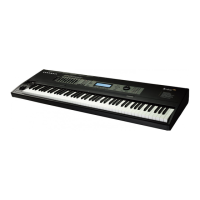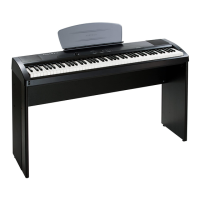3-8
Disk Partitioning
Disk Mode
If you’re running an operating system older than 8.5, your Mac will probably not be able to
address the last partition on the disk. If you have the Formatter 5 utility from Software
Architects, you may be able to make the last partition visible (we can’t guarantee that this will
work):
1. Start with a hard format (see the procedure on page 3-3).
2. Format the disk with Formatter 5 (see the Formatter 5 instructions).
3. Use Mac/PC manager (a utility provided with Formatter 5) or DOS Mounter 95 (also
available from Software Architects) to view the partitions.
Other Macintosh Issues
There are several things to keep mind when attempting to use a Mac with disks formatted for
the K2600.
First, we recommend using MacOS 8.5 or later, and version 3.0.2 (or later) of the File Exchange
system extension. This combination has given the best results, especially for disks formatted
with the K2600. With this configuration you can read most partitioned DOS disks, but you can’t
format them.
On Macs running operating systems prior to 8.5, you can use Formatter 5 (and its accompanying
extension, Mac/PC manager). these work reasonably well for formatting and reading small
disks. Results are unreliable for disks larger than 2 G, however. Formatter 5 often has trouble
reading any partition but the first, even on disks formatted with the K2600. You might also try
DOS Mounter 95, also available from Software Architects.
Disk Mode
Disk mode has changed slightly to accommodate support for partitions. The changes affect
several operations to varying degrees. We’ve already discussed the changes to the
formatting/partitioning procedure (see page 3-1); this section describes the changes to other
Disk-mode operations.
Basic Operations
This is how the Disk mode page looks when you’re viewing a hard disk. Note the partition ID
(0, which indicates the first partition), which is included in the path information. The
partition ID for unpartitioned disks is always 0. There’s no real limit to the number of partitions
your disk can contain; the K2600 should be able to read all of them. Nevertheless, 20 or so
partitions is a reasonable maximum.
DiskMode||||||||||||||||||||Memory:478K|
Path|=|0\PROGS\TRIPLES||||||||||||||||||
||||||||||||||||||||||||||||||||||||||||
CurrentDisk:SCSI|1||||||||Startup:Off|||
||||||||||||||||||||||||||Library:Off|||
Direct|Access,|10000MB||||Verify|:Off|||
MegaDisk|10||||||||||||||||J.02|||||||||
<more||Rename||Move|||Util||NewDir|more>|

